Economics for Managers: Addressing Negative Externalities
VerifiedAdded on 2023/06/08
|20
|4229
|426
Essay
AI Summary
This essay discusses the concept of negative externalities and associated market failures, focusing on the Indian petrochemical industry as a case study. It explains how the industry contributes to pollution and the measures taken by the government to address these externalities, using economic theory and diagrams to illustrate the points. The essay also suggests policies to address negative externalities, including market-based instruments and innovative funding mechanisms. It identifies the market structure of the Indian petrochemical industry as largely an oligopoly and highlights the need for government intervention to correct negative externalities and restore market efficiency. The document is available on Desklib, a platform offering a wide range of study tools and solved assignments for students.

Running Head: ECONOMICS FOR MANAGERS
Economics for Managers
Name of the Student
Name of the University
Course ID
Economics for Managers
Name of the Student
Name of the University
Course ID
Paraphrase This Document
Need a fresh take? Get an instant paraphrase of this document with our AI Paraphraser

1ECONOMICS FOR MANAGERS
Externality in economics is defined as the added cost or benefit of an economic
transaction that influences a third party who does not involve in the activity. Economic
transactions that incurs an external cost is said to constitute negative externality. Positive
externality on the other hand is the additional benefit enjoyed by the society. Both type of
externality hampers the efficient functioning of free market. The problem is that private parties
do not account the external cost or external benefit of the activity (Iossa & Martimort, 2015). In
a free market, goods constituting external cost or external benefits are either overproduced or
under produced.
The essay aims to discusses negative externality and associated market failure in
reference to a real world industry. The specific industry chosen for the assignment is Indian
Petrochemical industry. The single industry is responsible for causing considerable pollution in
land, air and water. Some measures have been taken by the government to address the externality
in the particular industry. In reference to degree of competition, markets are classified into four
major categories, each having its own specification (Cowell, 2018). The market structure of
Indian petrochemical industry is largely an oligopoly market. The presence of market power and
collusive behavior of dominant players in the industry results in inefficient market outcome.
Negative externality and market failure
Negative externality arises when an individual or firm does not bear the full cost of a
particular decision. This is an external cost imposed on a third party, neither directly nor
indirectly related to the transaction. In the presence of negative externality, society bears the
additional cost of the activity. In an unregulated market, such costs are not reflected in the
market price. In the free market, decision of buyers depends on the associated marginal benefit
and marginal cost of the activity.
Externality in economics is defined as the added cost or benefit of an economic
transaction that influences a third party who does not involve in the activity. Economic
transactions that incurs an external cost is said to constitute negative externality. Positive
externality on the other hand is the additional benefit enjoyed by the society. Both type of
externality hampers the efficient functioning of free market. The problem is that private parties
do not account the external cost or external benefit of the activity (Iossa & Martimort, 2015). In
a free market, goods constituting external cost or external benefits are either overproduced or
under produced.
The essay aims to discusses negative externality and associated market failure in
reference to a real world industry. The specific industry chosen for the assignment is Indian
Petrochemical industry. The single industry is responsible for causing considerable pollution in
land, air and water. Some measures have been taken by the government to address the externality
in the particular industry. In reference to degree of competition, markets are classified into four
major categories, each having its own specification (Cowell, 2018). The market structure of
Indian petrochemical industry is largely an oligopoly market. The presence of market power and
collusive behavior of dominant players in the industry results in inefficient market outcome.
Negative externality and market failure
Negative externality arises when an individual or firm does not bear the full cost of a
particular decision. This is an external cost imposed on a third party, neither directly nor
indirectly related to the transaction. In the presence of negative externality, society bears the
additional cost of the activity. In an unregulated market, such costs are not reflected in the
market price. In the free market, decision of buyers depends on the associated marginal benefit
and marginal cost of the activity.
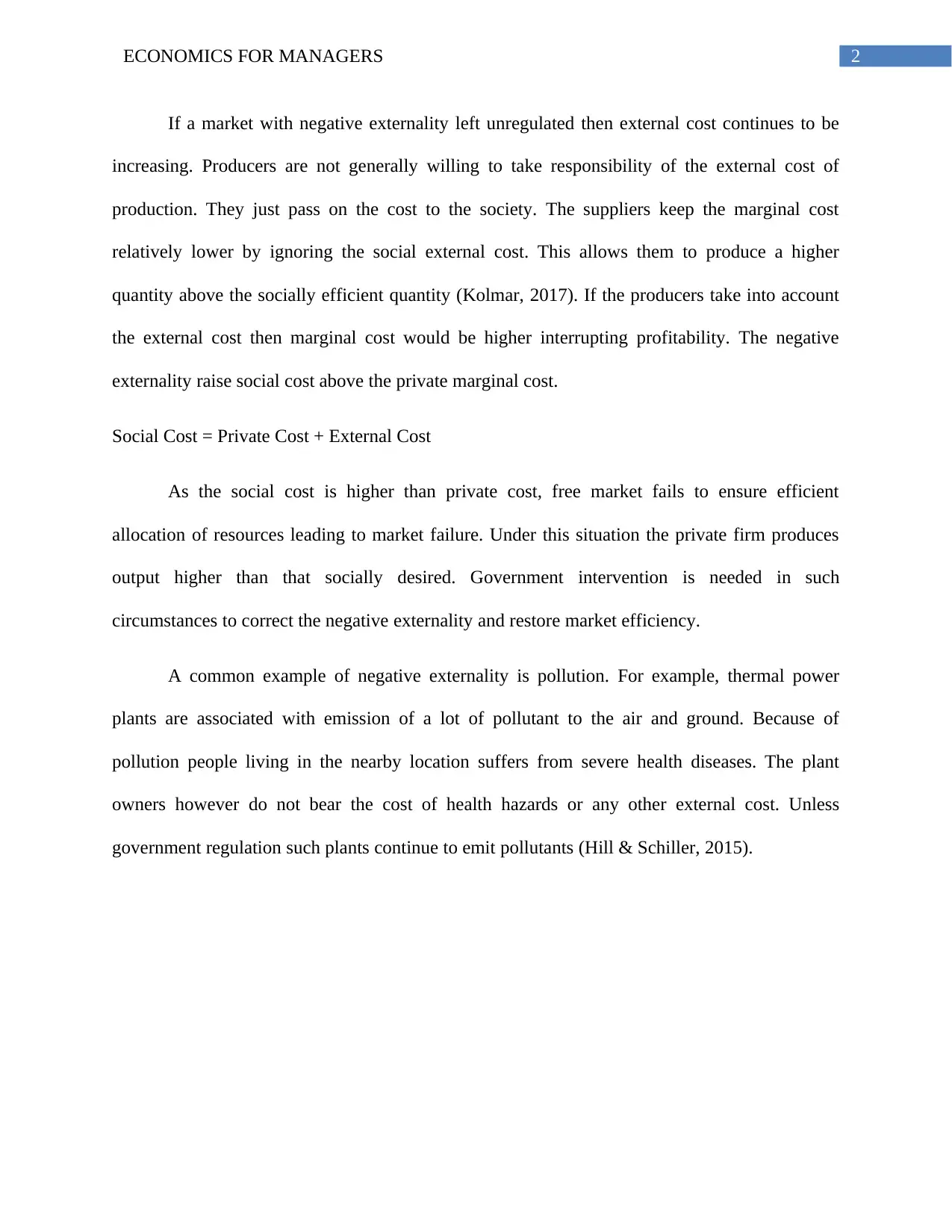
2ECONOMICS FOR MANAGERS
If a market with negative externality left unregulated then external cost continues to be
increasing. Producers are not generally willing to take responsibility of the external cost of
production. They just pass on the cost to the society. The suppliers keep the marginal cost
relatively lower by ignoring the social external cost. This allows them to produce a higher
quantity above the socially efficient quantity (Kolmar, 2017). If the producers take into account
the external cost then marginal cost would be higher interrupting profitability. The negative
externality raise social cost above the private marginal cost.
Social Cost = Private Cost + External Cost
As the social cost is higher than private cost, free market fails to ensure efficient
allocation of resources leading to market failure. Under this situation the private firm produces
output higher than that socially desired. Government intervention is needed in such
circumstances to correct the negative externality and restore market efficiency.
A common example of negative externality is pollution. For example, thermal power
plants are associated with emission of a lot of pollutant to the air and ground. Because of
pollution people living in the nearby location suffers from severe health diseases. The plant
owners however do not bear the cost of health hazards or any other external cost. Unless
government regulation such plants continue to emit pollutants (Hill & Schiller, 2015).
If a market with negative externality left unregulated then external cost continues to be
increasing. Producers are not generally willing to take responsibility of the external cost of
production. They just pass on the cost to the society. The suppliers keep the marginal cost
relatively lower by ignoring the social external cost. This allows them to produce a higher
quantity above the socially efficient quantity (Kolmar, 2017). If the producers take into account
the external cost then marginal cost would be higher interrupting profitability. The negative
externality raise social cost above the private marginal cost.
Social Cost = Private Cost + External Cost
As the social cost is higher than private cost, free market fails to ensure efficient
allocation of resources leading to market failure. Under this situation the private firm produces
output higher than that socially desired. Government intervention is needed in such
circumstances to correct the negative externality and restore market efficiency.
A common example of negative externality is pollution. For example, thermal power
plants are associated with emission of a lot of pollutant to the air and ground. Because of
pollution people living in the nearby location suffers from severe health diseases. The plant
owners however do not bear the cost of health hazards or any other external cost. Unless
government regulation such plants continue to emit pollutants (Hill & Schiller, 2015).
⊘ This is a preview!⊘
Do you want full access?
Subscribe today to unlock all pages.

Trusted by 1+ million students worldwide

3ECONOMICS FOR MANAGERS
Figure 1: Negative externality and marginal cost
In the above figure, the horizontal and vertical axes represent quantity and prices
respectively. The demand curve or marginal benefit curve is given as D. Because of negative
externality the marginal social cost is different from marginal private cost. S1 presents the
private marginal cost. The social marginal cost is given as S. If X is the external cost, then social
marginal cost = Private marginal cost + X. The free market equilibrium occurs at O (intersection
of private marginal cost and marginal benefit). Under free market, Q1 amount of output would
be produced. The socially efficient output however is at Q (intersection of social marginal cost
and marginal benefit). There is thus overproduction of goods because of negative externality.
The cost on society or welfare loss is given by the area of triangle MNO.
Negative externality: A case study of Indian petrochemical industry
Most industries are associated with one common form of externality called pollution.
Chemical industry in India is one of the most pollution generating industry imposing a negative
externality on the environment. India is known for having a large and advanced chemical
industry among the developing nations. The industry has various subsectors engaged in
Figure 1: Negative externality and marginal cost
In the above figure, the horizontal and vertical axes represent quantity and prices
respectively. The demand curve or marginal benefit curve is given as D. Because of negative
externality the marginal social cost is different from marginal private cost. S1 presents the
private marginal cost. The social marginal cost is given as S. If X is the external cost, then social
marginal cost = Private marginal cost + X. The free market equilibrium occurs at O (intersection
of private marginal cost and marginal benefit). Under free market, Q1 amount of output would
be produced. The socially efficient output however is at Q (intersection of social marginal cost
and marginal benefit). There is thus overproduction of goods because of negative externality.
The cost on society or welfare loss is given by the area of triangle MNO.
Negative externality: A case study of Indian petrochemical industry
Most industries are associated with one common form of externality called pollution.
Chemical industry in India is one of the most pollution generating industry imposing a negative
externality on the environment. India is known for having a large and advanced chemical
industry among the developing nations. The industry has various subsectors engaged in
Paraphrase This Document
Need a fresh take? Get an instant paraphrase of this document with our AI Paraphraser

4ECONOMICS FOR MANAGERS
production petroleum product, fertilizers, pharmaceuticals, pesticides and different organic and
inorganic chemicals. The industry discharges harmful toxic chemicals leading to destruction of
soil, vegetation and water. The chemical plants even release cyanides which caused 50000 fish
water to die in Meerut Kai River in the year 1984 (environmentalpollution.in, 2018).
Petrochemical industry
Petrochemical industry is one of the important industries in Indian. Indian petrochemical
industry constitutes 2 percent of global market. The industry accounts a growth rate of nearly 10
percent. Producing a wide variety of product, the industry incurs profit of around 14 percent
(business.mapsofindia.com, 2018). However, despite having positive contribution to economic
growth the sector an adverse impact on environment quality.
Hazards associated with petrochemical and subsidiary industry
The waste generated from petrochemical industry is injurious to health as it contains
several harmful substances. This imposes an external cost on standard of living and environment.
The discharged waste has an unfavorable impact on environment and lead to air, water and soil
pollution. An important pollutant component emitted from petrochemical industry is aromatic
components. The aromatic compounds from the industry introduces into the environment
through leaks of natural oil, waste product and emission from industries, waste released during
oil shortage, industrial effluents, spills from oil tanker, processing waste and others (Saxena &
Singh, 2017). The main elements of petrochemical industries causing air pollution are Sulphur
oxides and other compounds made of Sulphur, nitrogen oxide and other nitrogen compounds,
Halogens and its components, different volatile organic compounds (VOC) and particular matter
production petroleum product, fertilizers, pharmaceuticals, pesticides and different organic and
inorganic chemicals. The industry discharges harmful toxic chemicals leading to destruction of
soil, vegetation and water. The chemical plants even release cyanides which caused 50000 fish
water to die in Meerut Kai River in the year 1984 (environmentalpollution.in, 2018).
Petrochemical industry
Petrochemical industry is one of the important industries in Indian. Indian petrochemical
industry constitutes 2 percent of global market. The industry accounts a growth rate of nearly 10
percent. Producing a wide variety of product, the industry incurs profit of around 14 percent
(business.mapsofindia.com, 2018). However, despite having positive contribution to economic
growth the sector an adverse impact on environment quality.
Hazards associated with petrochemical and subsidiary industry
The waste generated from petrochemical industry is injurious to health as it contains
several harmful substances. This imposes an external cost on standard of living and environment.
The discharged waste has an unfavorable impact on environment and lead to air, water and soil
pollution. An important pollutant component emitted from petrochemical industry is aromatic
components. The aromatic compounds from the industry introduces into the environment
through leaks of natural oil, waste product and emission from industries, waste released during
oil shortage, industrial effluents, spills from oil tanker, processing waste and others (Saxena &
Singh, 2017). The main elements of petrochemical industries causing air pollution are Sulphur
oxides and other compounds made of Sulphur, nitrogen oxide and other nitrogen compounds,
Halogens and its components, different volatile organic compounds (VOC) and particular matter
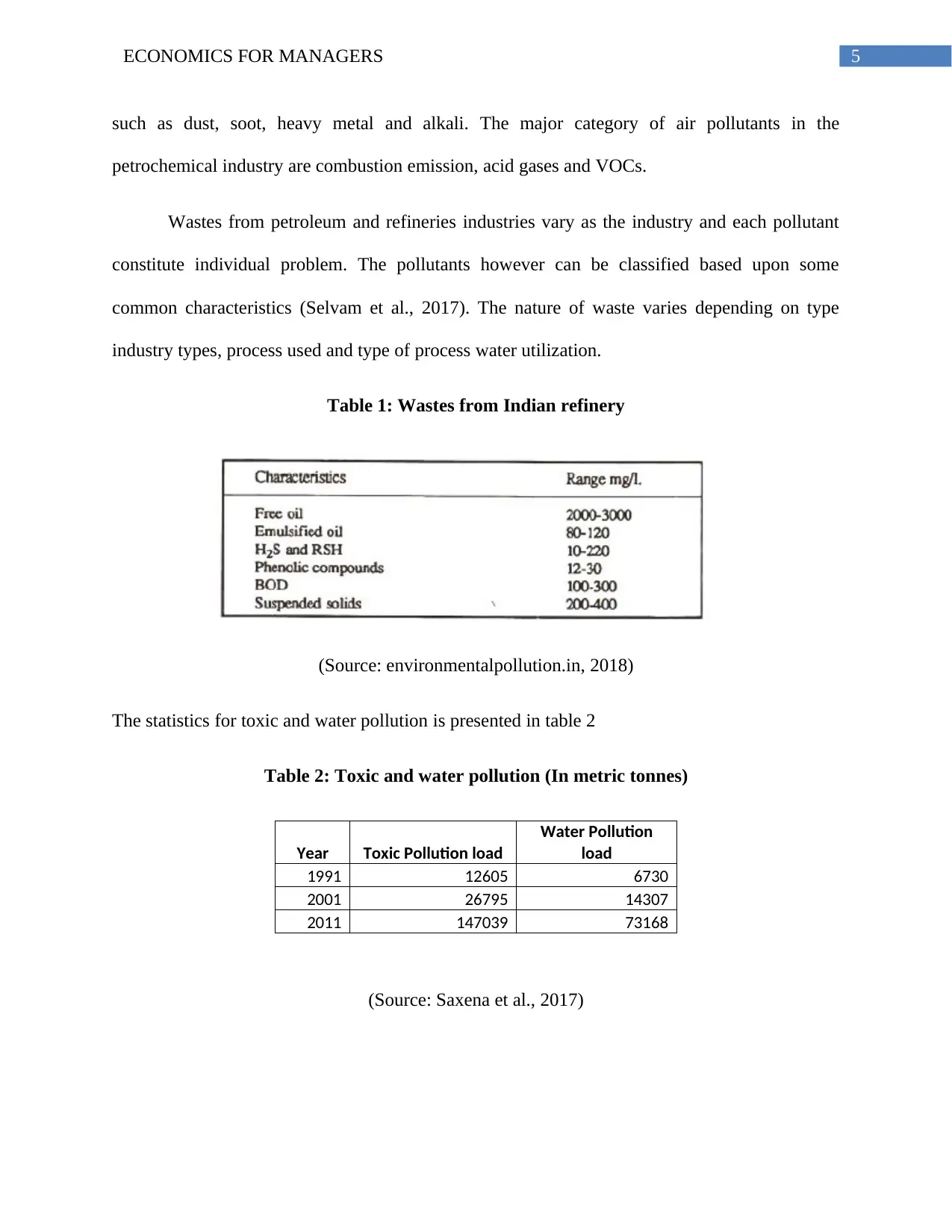
5ECONOMICS FOR MANAGERS
such as dust, soot, heavy metal and alkali. The major category of air pollutants in the
petrochemical industry are combustion emission, acid gases and VOCs.
Wastes from petroleum and refineries industries vary as the industry and each pollutant
constitute individual problem. The pollutants however can be classified based upon some
common characteristics (Selvam et al., 2017). The nature of waste varies depending on type
industry types, process used and type of process water utilization.
Table 1: Wastes from Indian refinery
(Source: environmentalpollution.in, 2018)
The statistics for toxic and water pollution is presented in table 2
Table 2: Toxic and water pollution (In metric tonnes)
Year Toxic Pollution load
Water Pollution
load
1991 12605 6730
2001 26795 14307
2011 147039 73168
(Source: Saxena et al., 2017)
such as dust, soot, heavy metal and alkali. The major category of air pollutants in the
petrochemical industry are combustion emission, acid gases and VOCs.
Wastes from petroleum and refineries industries vary as the industry and each pollutant
constitute individual problem. The pollutants however can be classified based upon some
common characteristics (Selvam et al., 2017). The nature of waste varies depending on type
industry types, process used and type of process water utilization.
Table 1: Wastes from Indian refinery
(Source: environmentalpollution.in, 2018)
The statistics for toxic and water pollution is presented in table 2
Table 2: Toxic and water pollution (In metric tonnes)
Year Toxic Pollution load
Water Pollution
load
1991 12605 6730
2001 26795 14307
2011 147039 73168
(Source: Saxena et al., 2017)
⊘ This is a preview!⊘
Do you want full access?
Subscribe today to unlock all pages.

Trusted by 1+ million students worldwide
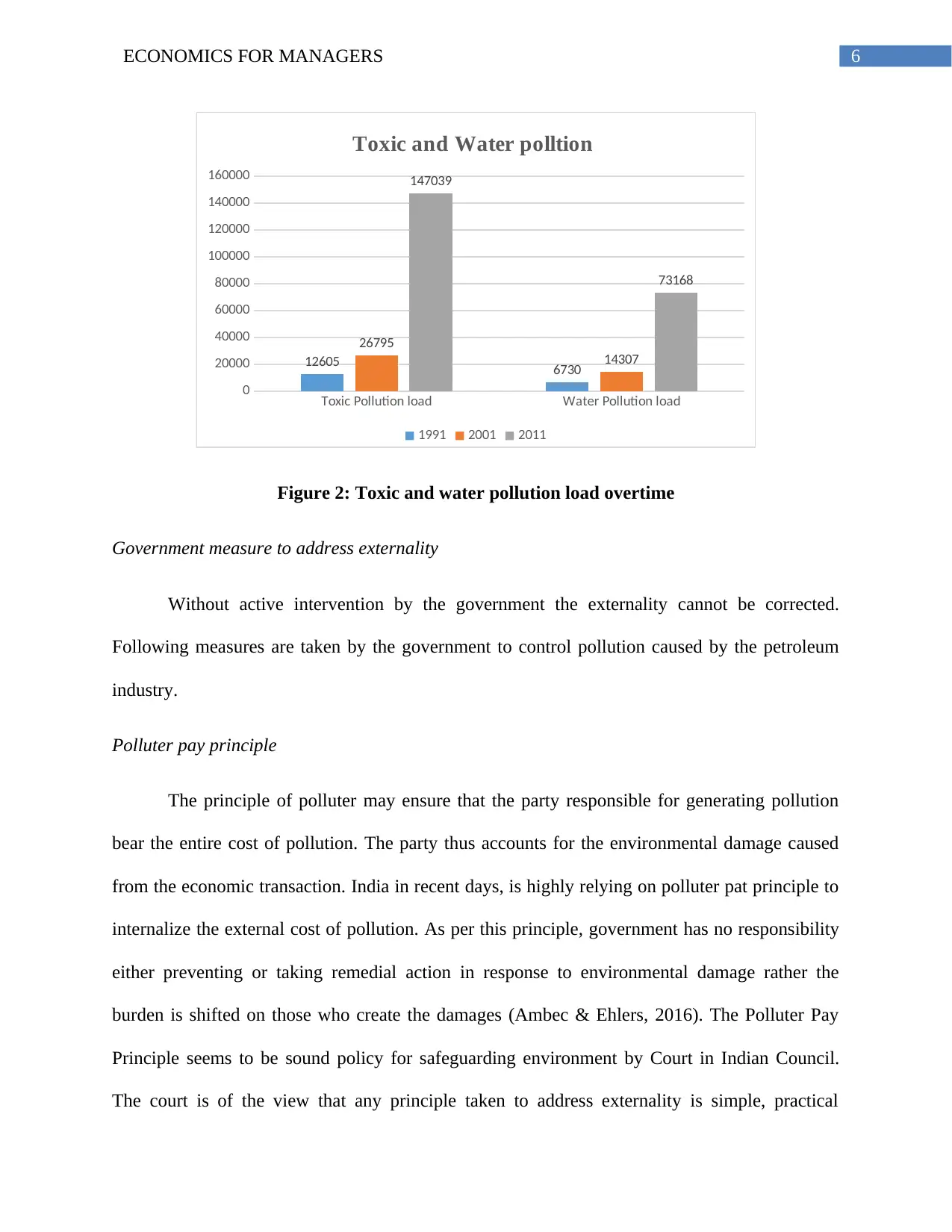
6ECONOMICS FOR MANAGERS
Toxic Pollution load Water Pollution load
0
20000
40000
60000
80000
100000
120000
140000
160000
12605 6730
26795
14307
147039
73168
Toxic and Water polltion
1991 2001 2011
Figure 2: Toxic and water pollution load overtime
Government measure to address externality
Without active intervention by the government the externality cannot be corrected.
Following measures are taken by the government to control pollution caused by the petroleum
industry.
Polluter pay principle
The principle of polluter may ensure that the party responsible for generating pollution
bear the entire cost of pollution. The party thus accounts for the environmental damage caused
from the economic transaction. India in recent days, is highly relying on polluter pat principle to
internalize the external cost of pollution. As per this principle, government has no responsibility
either preventing or taking remedial action in response to environmental damage rather the
burden is shifted on those who create the damages (Ambec & Ehlers, 2016). The Polluter Pay
Principle seems to be sound policy for safeguarding environment by Court in Indian Council.
The court is of the view that any principle taken to address externality is simple, practical
Toxic Pollution load Water Pollution load
0
20000
40000
60000
80000
100000
120000
140000
160000
12605 6730
26795
14307
147039
73168
Toxic and Water polltion
1991 2001 2011
Figure 2: Toxic and water pollution load overtime
Government measure to address externality
Without active intervention by the government the externality cannot be corrected.
Following measures are taken by the government to control pollution caused by the petroleum
industry.
Polluter pay principle
The principle of polluter may ensure that the party responsible for generating pollution
bear the entire cost of pollution. The party thus accounts for the environmental damage caused
from the economic transaction. India in recent days, is highly relying on polluter pat principle to
internalize the external cost of pollution. As per this principle, government has no responsibility
either preventing or taking remedial action in response to environmental damage rather the
burden is shifted on those who create the damages (Ambec & Ehlers, 2016). The Polluter Pay
Principle seems to be sound policy for safeguarding environment by Court in Indian Council.
The court is of the view that any principle taken to address externality is simple, practical
Paraphrase This Document
Need a fresh take? Get an instant paraphrase of this document with our AI Paraphraser
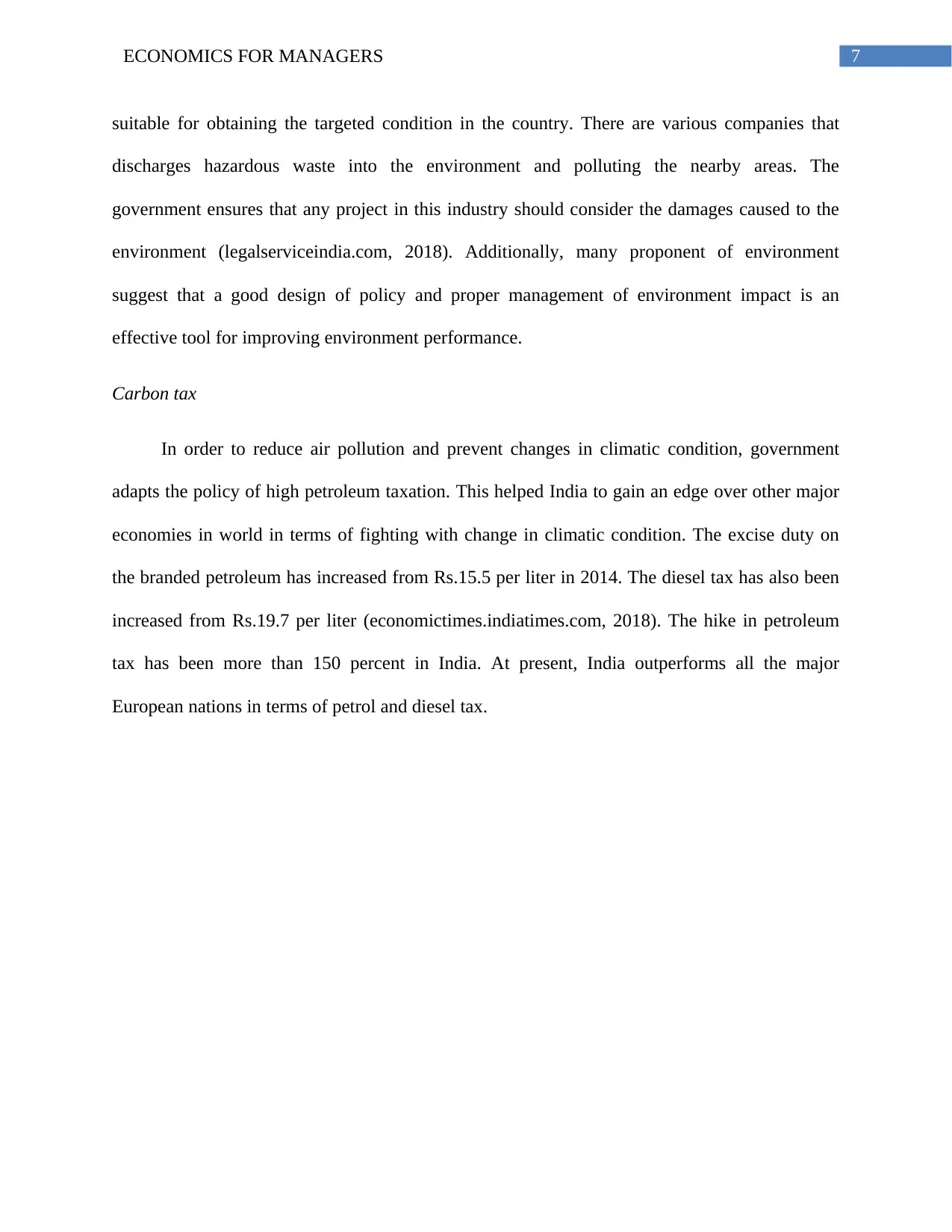
7ECONOMICS FOR MANAGERS
suitable for obtaining the targeted condition in the country. There are various companies that
discharges hazardous waste into the environment and polluting the nearby areas. The
government ensures that any project in this industry should consider the damages caused to the
environment (legalserviceindia.com, 2018). Additionally, many proponent of environment
suggest that a good design of policy and proper management of environment impact is an
effective tool for improving environment performance.
Carbon tax
In order to reduce air pollution and prevent changes in climatic condition, government
adapts the policy of high petroleum taxation. This helped India to gain an edge over other major
economies in world in terms of fighting with change in climatic condition. The excise duty on
the branded petroleum has increased from Rs.15.5 per liter in 2014. The diesel tax has also been
increased from Rs.19.7 per liter (economictimes.indiatimes.com, 2018). The hike in petroleum
tax has been more than 150 percent in India. At present, India outperforms all the major
European nations in terms of petrol and diesel tax.
suitable for obtaining the targeted condition in the country. There are various companies that
discharges hazardous waste into the environment and polluting the nearby areas. The
government ensures that any project in this industry should consider the damages caused to the
environment (legalserviceindia.com, 2018). Additionally, many proponent of environment
suggest that a good design of policy and proper management of environment impact is an
effective tool for improving environment performance.
Carbon tax
In order to reduce air pollution and prevent changes in climatic condition, government
adapts the policy of high petroleum taxation. This helped India to gain an edge over other major
economies in world in terms of fighting with change in climatic condition. The excise duty on
the branded petroleum has increased from Rs.15.5 per liter in 2014. The diesel tax has also been
increased from Rs.19.7 per liter (economictimes.indiatimes.com, 2018). The hike in petroleum
tax has been more than 150 percent in India. At present, India outperforms all the major
European nations in terms of petrol and diesel tax.
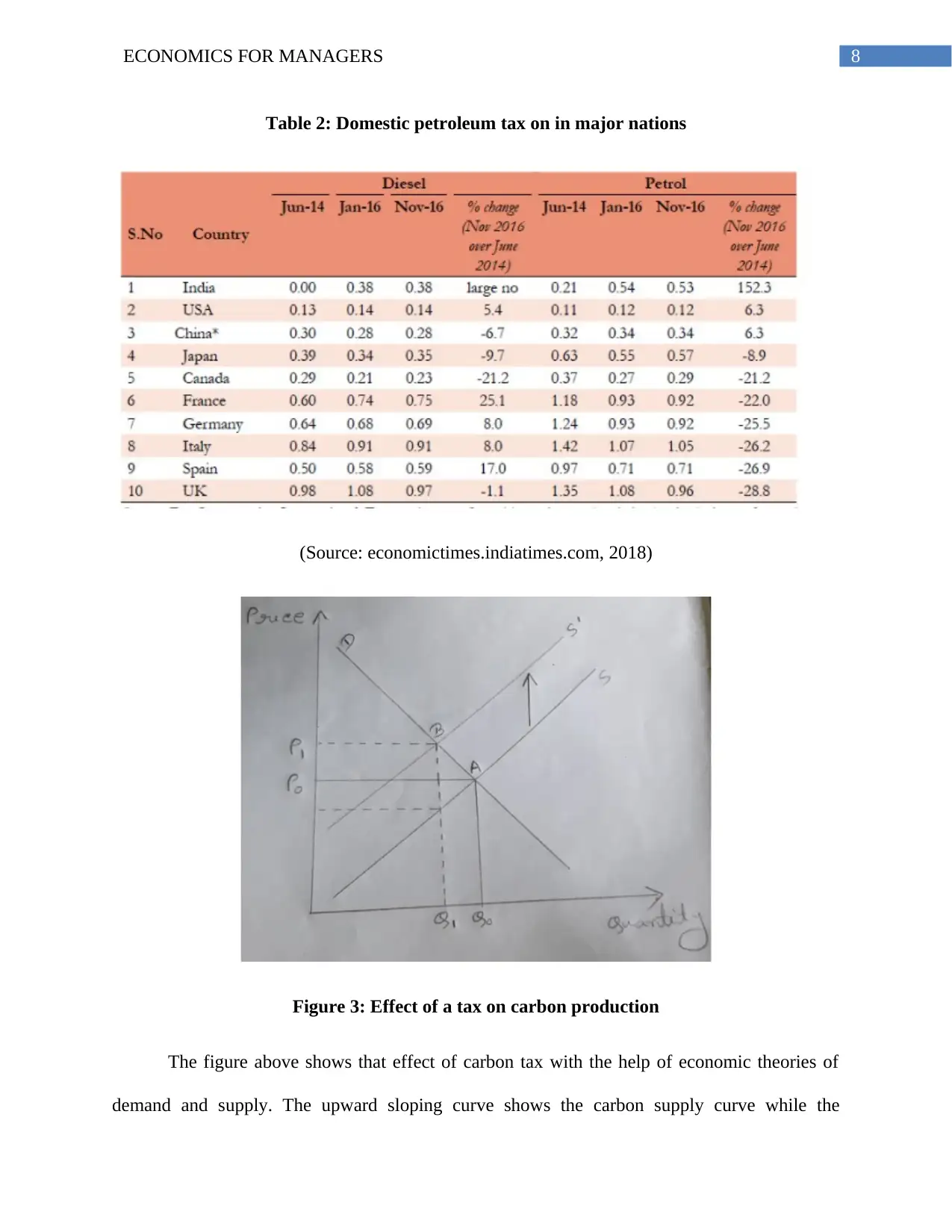
8ECONOMICS FOR MANAGERS
Table 2: Domestic petroleum tax on in major nations
(Source: economictimes.indiatimes.com, 2018)
Figure 3: Effect of a tax on carbon production
The figure above shows that effect of carbon tax with the help of economic theories of
demand and supply. The upward sloping curve shows the carbon supply curve while the
Table 2: Domestic petroleum tax on in major nations
(Source: economictimes.indiatimes.com, 2018)
Figure 3: Effect of a tax on carbon production
The figure above shows that effect of carbon tax with the help of economic theories of
demand and supply. The upward sloping curve shows the carbon supply curve while the
⊘ This is a preview!⊘
Do you want full access?
Subscribe today to unlock all pages.

Trusted by 1+ million students worldwide
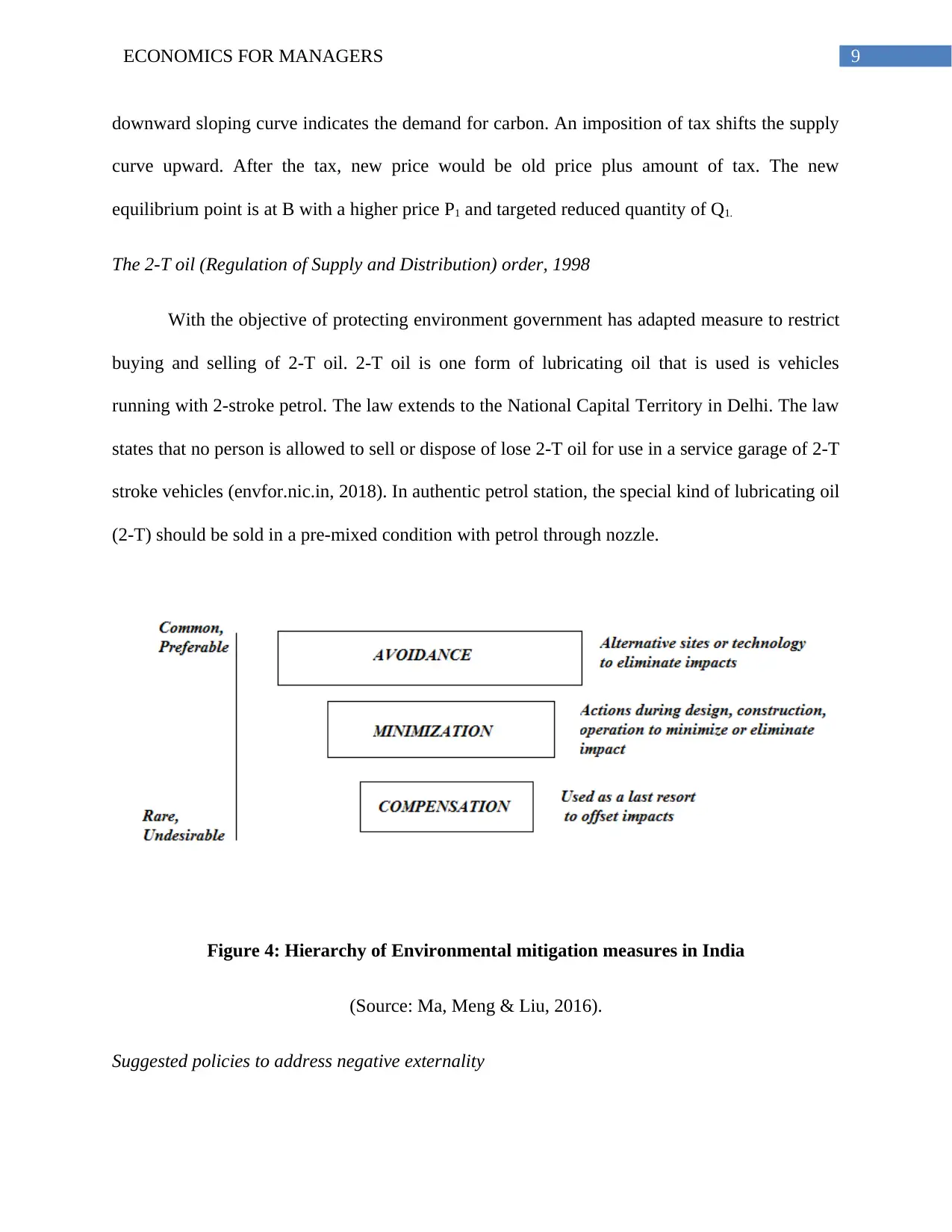
9ECONOMICS FOR MANAGERS
downward sloping curve indicates the demand for carbon. An imposition of tax shifts the supply
curve upward. After the tax, new price would be old price plus amount of tax. The new
equilibrium point is at B with a higher price P1 and targeted reduced quantity of Q1.
The 2-T oil (Regulation of Supply and Distribution) order, 1998
With the objective of protecting environment government has adapted measure to restrict
buying and selling of 2-T oil. 2-T oil is one form of lubricating oil that is used is vehicles
running with 2-stroke petrol. The law extends to the National Capital Territory in Delhi. The law
states that no person is allowed to sell or dispose of lose 2-T oil for use in a service garage of 2-T
stroke vehicles (envfor.nic.in, 2018). In authentic petrol station, the special kind of lubricating oil
(2-T) should be sold in a pre-mixed condition with petrol through nozzle.
Figure 4: Hierarchy of Environmental mitigation measures in India
(Source: Ma, Meng & Liu, 2016).
Suggested policies to address negative externality
downward sloping curve indicates the demand for carbon. An imposition of tax shifts the supply
curve upward. After the tax, new price would be old price plus amount of tax. The new
equilibrium point is at B with a higher price P1 and targeted reduced quantity of Q1.
The 2-T oil (Regulation of Supply and Distribution) order, 1998
With the objective of protecting environment government has adapted measure to restrict
buying and selling of 2-T oil. 2-T oil is one form of lubricating oil that is used is vehicles
running with 2-stroke petrol. The law extends to the National Capital Territory in Delhi. The law
states that no person is allowed to sell or dispose of lose 2-T oil for use in a service garage of 2-T
stroke vehicles (envfor.nic.in, 2018). In authentic petrol station, the special kind of lubricating oil
(2-T) should be sold in a pre-mixed condition with petrol through nozzle.
Figure 4: Hierarchy of Environmental mitigation measures in India
(Source: Ma, Meng & Liu, 2016).
Suggested policies to address negative externality
Paraphrase This Document
Need a fresh take? Get an instant paraphrase of this document with our AI Paraphraser
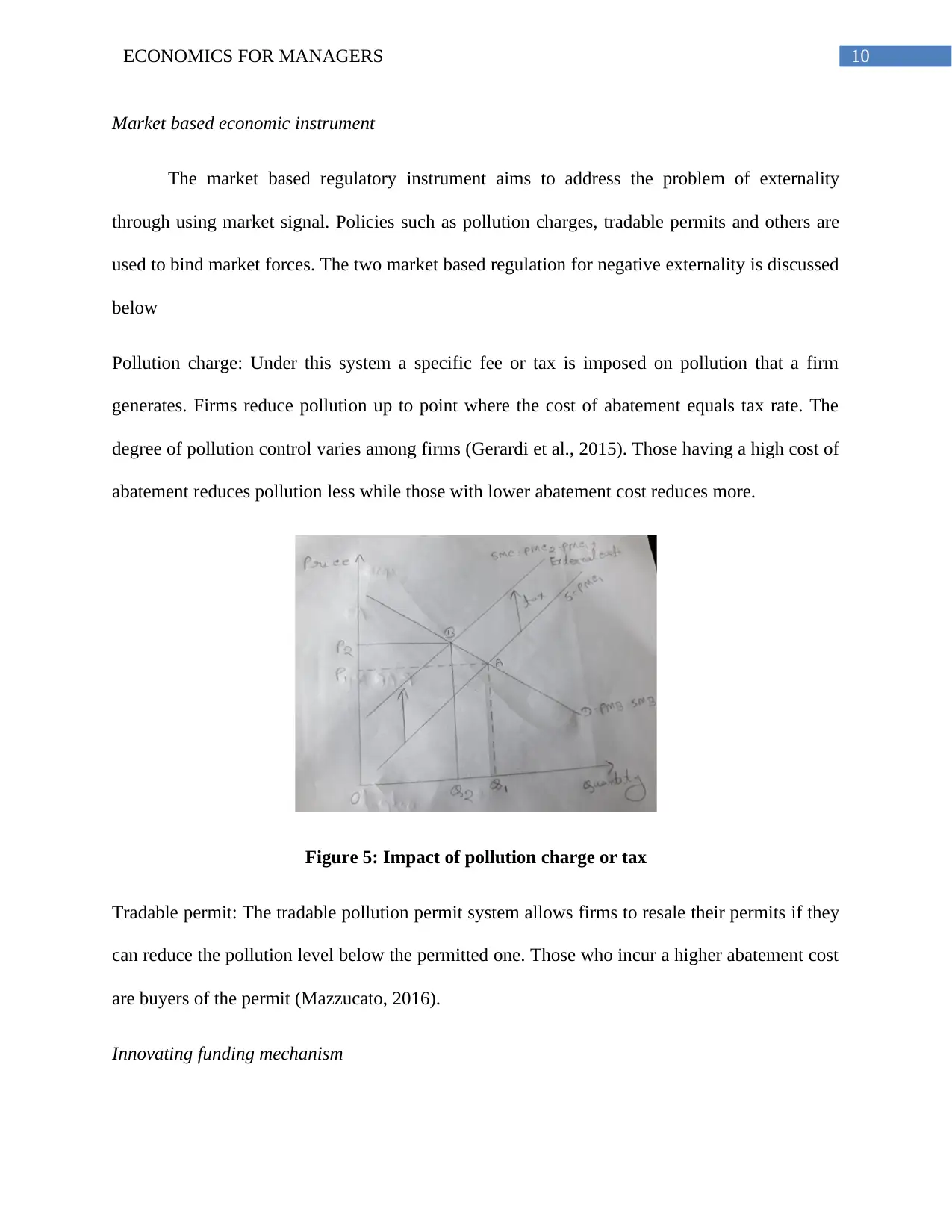
10ECONOMICS FOR MANAGERS
Market based economic instrument
The market based regulatory instrument aims to address the problem of externality
through using market signal. Policies such as pollution charges, tradable permits and others are
used to bind market forces. The two market based regulation for negative externality is discussed
below
Pollution charge: Under this system a specific fee or tax is imposed on pollution that a firm
generates. Firms reduce pollution up to point where the cost of abatement equals tax rate. The
degree of pollution control varies among firms (Gerardi et al., 2015). Those having a high cost of
abatement reduces pollution less while those with lower abatement cost reduces more.
Figure 5: Impact of pollution charge or tax
Tradable permit: The tradable pollution permit system allows firms to resale their permits if they
can reduce the pollution level below the permitted one. Those who incur a higher abatement cost
are buyers of the permit (Mazzucato, 2016).
Innovating funding mechanism
Market based economic instrument
The market based regulatory instrument aims to address the problem of externality
through using market signal. Policies such as pollution charges, tradable permits and others are
used to bind market forces. The two market based regulation for negative externality is discussed
below
Pollution charge: Under this system a specific fee or tax is imposed on pollution that a firm
generates. Firms reduce pollution up to point where the cost of abatement equals tax rate. The
degree of pollution control varies among firms (Gerardi et al., 2015). Those having a high cost of
abatement reduces pollution less while those with lower abatement cost reduces more.
Figure 5: Impact of pollution charge or tax
Tradable permit: The tradable pollution permit system allows firms to resale their permits if they
can reduce the pollution level below the permitted one. Those who incur a higher abatement cost
are buyers of the permit (Mazzucato, 2016).
Innovating funding mechanism

11ECONOMICS FOR MANAGERS
There are many international forums that makes funds available for environment concern.
Incentives should be taken at local level to increase funding for pollution control. There are other
options through which funds can be raised for controlling pollution. Funds are raised
automatically if government imposes pollution charge or tax (Ma, Meng & Liu, 2016). The funds
should be utilized properly for purpose of environment protection.
Figure 6: Market for tradable pollution permit
Cleaner production
Promotion of clean production has useful implication for controlling environmental
pollution. Principles of cleaner production implies promotion of production of desired level of
output by optimizing use of raw material along with minimizing pollution as much as possible.
Market Structure
The four main forms of market structures are perfect competition, monopoly, monopolistic
competition and oligopoly.
Perfect competition
There are many international forums that makes funds available for environment concern.
Incentives should be taken at local level to increase funding for pollution control. There are other
options through which funds can be raised for controlling pollution. Funds are raised
automatically if government imposes pollution charge or tax (Ma, Meng & Liu, 2016). The funds
should be utilized properly for purpose of environment protection.
Figure 6: Market for tradable pollution permit
Cleaner production
Promotion of clean production has useful implication for controlling environmental
pollution. Principles of cleaner production implies promotion of production of desired level of
output by optimizing use of raw material along with minimizing pollution as much as possible.
Market Structure
The four main forms of market structures are perfect competition, monopoly, monopolistic
competition and oligopoly.
Perfect competition
⊘ This is a preview!⊘
Do you want full access?
Subscribe today to unlock all pages.

Trusted by 1+ million students worldwide
1 out of 20
Related Documents
Your All-in-One AI-Powered Toolkit for Academic Success.
+13062052269
info@desklib.com
Available 24*7 on WhatsApp / Email
![[object Object]](/_next/static/media/star-bottom.7253800d.svg)
Unlock your academic potential
Copyright © 2020–2026 A2Z Services. All Rights Reserved. Developed and managed by ZUCOL.





